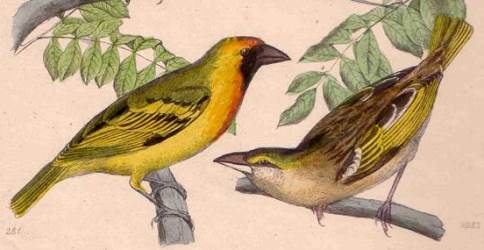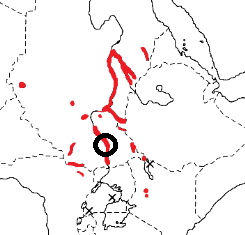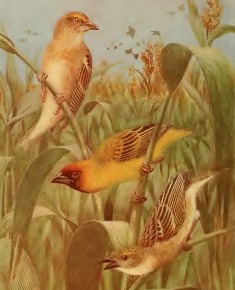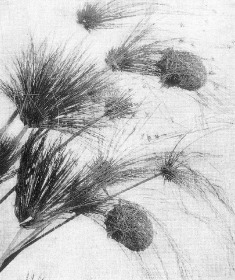Weaver species list / RELATED SPECIES: Cinnamon Weaver / Golden Palm Weaver / Kilombero Weaver / Northern Brown-throated Weaver / Northern Masked Weaver / Ruvu Weaver / Southern Brown-throated Weaver / Taveta Golden Weaver / Village Weaver / Yellow-backed Weaver
IUCN: Least concern Discovery: 064
Categories: wetland, pest
Discovery
  
IntroductionThe Northern Masked Weaver was formally described by Heinrich Gottlieb Ludwig Reichenbach, a German botanist and ornithologist. Reichenbach was a prolific author and wrote a book describing many weavers known at his time. He described many new subspecies of weaver, but the only full species of weaver was the Northern Masked Weaver. Reichenbach wrote in German but provided the first English names for many species (although most of his English names are no longer in use). The Northern Masked Weaver had been collected by Gustav Boleslawski von der Trenck, a military officer. He travelled in NE Africa from 1857-1861. Major von Boleslavski sent the relatively few birds that he had collected to Pelzeln at the Museum in Vienna. He collected the Northern Masked Weaver at Gondokorro, a trading-station on the east bank of the White Nile in Southern Sudan. The first illustration of the Northern Masked Weaver was of a male and female, published by Reichenbach (1863). The next illustration pertaining to Northern Masked Weaver was of the head of a male by Heuglin (1871). Scientific citationPloceus taeniopterus Reichenbach 1863 Singvögel, p.78, pl. 36, figs. 281, 282 Sudan. Meaning of namestaeniopterus Greek: Tainia, a band; -pteros, winged. [refers to wing bars, found in this species, but also other weavers] First English nameThe banded-winged Ploceole (Reichenbach 1863). Alternate namesDarfur Masked Weaver, Nile Masked Weaver. CollectorMajor von Boleslavski. Date collectedBetween 1857 and 1861. Locality collectedGondokorro, Sudan. Type specimensThe type specimen is in the Vienna Museum syntype NMW 33.998 (Schifter 2004), with a syntype SMTD-98 in Dresden Museum (Eck 2004). |
The above is based on Weaver Wednesday 2, a weekly series about the discovery of each weaver species.
This species text first appeared as Weaver Wednesday [181] – Discovery [64]: Northern Masked Weaver on 2015-12-02
1. Basic biology
 Identification. The Northern Masked Weaver is a typical ‘masked weaver’. The male in breeding plumage is distinguished from other masked weavers by a combination of the brown eye and the black mask that extends as far as the breast. The female has a dark eye and yellow supercilium – the upperparts are browner and the bill is darker than in the female Vitelline Masked Weaver. The juvenile is similar to the juvenile Lesser Masked Weaver but the former has a grey eye and slightly thicker bill. Distribution. The Northern Masked Weaver is abundant in Sudan and South Sudan from Khartoum south along the Rahad River and the White Nile. It also occurs in south-west Ethiopia, north-east DRCongo on the Upper Uele River, and western Kenya at Lakes Baringo and Bogoria (see red on map above). The population in Darfur, western Sudan, was separated as a subspecies but specimens fall within the general range of plumage variation of the species, and it is thus treated as monotypic. Habitat. The Northern Masked Weaver inhabits tall grassland with acacia trees, along larger rivers and swamps. Outside the breeding season it forages in flocks and forms large roosts in marshes, away from its nesting areas. Food. The diet of the Northern Masked Weaver is mainly seeds, including those of cultivated sorghum and millet. It also feeds on snail shells, and insects including beetles and cockroaches. Nestlings are initially fed with insects. In parts of Sudan, flocks of thousands of Northern Masked Weavers and Ruppell’s Weaver cause extensive damage to crops.  Breeding. The Northern Masked Weaver is polygynous and colonial. Colonies may be small with less than 10 nests, or large with more than 30 nests. The nest is oval, with the entrance below and no tunnel. The outer shell is woven of strips of grass. A thick inner layer consists of broad grass strips, and a ceiling of grass heads is added. The nest lining, most probably added by the female, is a layer of grass strips with some plant or papyrus down. The nest is supported by vertical stems of reeds, long grass, papyrus stalks, or shrubs. There are 2-3 eggs in a clutch. The eggs are highly variable and may be green or brown, and plain or spotted with brown and red-brown markings. The female incubates the eggs and feeds the chicks. The last-hatched chick in a clutch often dies of starvation. Intraspecific brood parasitism is common in some populations; in addition to laying her own clutch, the female lays some eggs in the nests of other females. |
The above is based on Weaver Wednesday, a weekly series about weaver species.
This species text first appeared as Weaver Wednesday [71]: Northern Masked Weaver on 2013-10-23
2. Breeding facts
| Pair bond Polygynous Breeding season Nest site Nest building Colony size Clutch size Egg colour Egg size Incubation Chicks and nestling period |
Breeding information based on Handbook of the Birds of the World, Vol. 15.
3. Photos of Weaver Nests
 Vm 5610 |
 Vm 5579 |
Thumb-nails of recent PHOWN records

